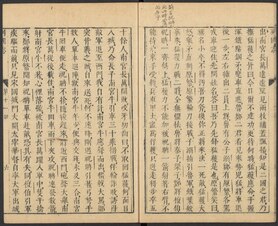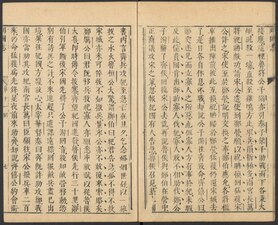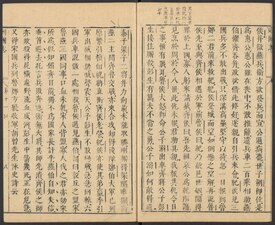 Illustration from a printed edition of the novel Illustration from a printed edition of the novel | |
| Author | Feng Menglong |
|---|---|
| Original title | 東周列國志 |
| Language | Chinese |
| Subject | Ancient China |
| Genre | Fictionalized history |
| Publication place | China |
| Media type | |
| Chronicles of the Eastern Zhou Kingdoms | |||||||
|---|---|---|---|---|---|---|---|
| Chinese name | |||||||
| Traditional Chinese | 東周列國志 | ||||||
| Simplified Chinese | 东周列国志 | ||||||
| |||||||
| Vietnamese name | |||||||
| Vietnamese alphabet | Đông Chu liệt quốc chí | ||||||
| Chữ Hán | 東周列國志 | ||||||
| Korean name | |||||||
| Hangul | 동주열국지 | ||||||
| Hanja | 東周列國志 | ||||||
| Japanese name | |||||||
| Kanji | 東周列国志 | ||||||
| Hiragana | とうしゅうれっこくし | ||||||
| |||||||
The Chronicles of the Eastern Zhou Kingdoms (simplified Chinese: 东周列国志; traditional Chinese: 東周列國志; pinyin: Dōngzhōu Lièguó Zhì) is a Chinese historical novel in 108 chapters written by Feng Menglong in the late Ming dynasty. Set in the Eastern Zhou dynasty, the novel starts from the Chinese kingdom beginning to break apart into smaller states and ends with the first unification of the land accomplished by Qin Shi Huang.
It is one of the best-known historical novels regarding ancient China. The novel based its sources from classic texts such as the Zuo Tradition and the Records of the Grand Historian and some of the sacred classic books of China such as the Book of Rites and the Classic of Poetry.
-
 Pages from a printed edition of the novel Chronicles of the East Zhou Kingdoms
Pages from a printed edition of the novel Chronicles of the East Zhou Kingdoms
-
 Pages from a printed edition of the novel Chronicles of the East Zhou Kingdoms
Pages from a printed edition of the novel Chronicles of the East Zhou Kingdoms
-
 Pages from a printed edition of the novel Chronicles of the East Zhou Kingdoms
Pages from a printed edition of the novel Chronicles of the East Zhou Kingdoms
Translations
The novel has been translated into several languages, including Korean, Thai and Vietnamese. The Korean version was done in 2003. The Thai version was done in 1819 by a committee of senior public officers at the behest of King Rama II. The Vietnamese version was done in 1933 by Nguyễn Đỗ Mục.
Erik Honobe has translated the first ten chapters into English (The Rise of Lord Zhuang of Zheng, ISBN 978-962-7255-48-2). Some chapters can be viewed on the website of Renditions: Chapter 1 and Chapter 5.
Olivia Milburn translated 17 out of the original 108 chapters into English. This translation was published as an abridged version of the novel in 2022 (Kingdoms in Peril: A Novel of the Ancient Chinese World at War, ISBN 9780520380516). In 2023, the fully-translated version was published in four volumes.
References
- Li, Wai-Yee (2010). "Full-Length Vernacular Fiction". In Mair, Victor H. (ed.). The Columbia History of Chinese Literature. New York: Columbia University Press. p. 625. ISBN 978-0-231-10984-0.
- "최이산씨, 원전 "열국지" 완역" (in Korean). kihoilbo. 2003-11-18. Retrieved 2014-08-26.
- Bayan Imsamran (n.d.). "War Strategics in Liadkok" (PDF). Surat Thani Rajabhat University Journal of Humanities and Social Sciences (in Thai). 15 (1).
{{cite journal}}: CS1 maint: year (link) - "Nguyễn Đỗ Mục" (in Vietnamese). daitudien. n.d. Retrieved 2014-08-26.
- Chaffetz, David (2022-03-14). "Two New Translations of Feng Menglong's Classic "Chronicles"". Asian Review of Books. Retrieved 2022-04-23.
- "New Book Announcement: "Kingdoms in Peril, Volumes 1-4" by Feng Menglong, translated by Olivia Milburn". Asian Review of Books. 2023-10-09. Retrieved 2024-04-18.
| Works by Feng Menglong | |
|---|---|
| Story collections | |
| Novels | |
This article about a 17th century novel is a stub. You can help Misplaced Pages by expanding it. See guidelines for writing about novels. Further suggestions might be found on the article's talk page. |
This article about a historical novel is a stub. You can help Misplaced Pages by expanding it. See guidelines for writing about novels. Further suggestions might be found on the article's talk page. |
- Ming dynasty novels
- 17th-century Chinese novels
- Works by Feng Menglong
- Novels set in the Zhou dynasty
- Warring States period in fiction
- Spring and Autumn period in fiction
- Chinese historical novels
- Novels set in Henan
- Novels set in Shandong
- Novels set in Hebei
- Novels set in Shanxi
- Novels set in Hubei
- Novels set in Shaanxi
- Novels set in Jiangsu
- Novels set in Zhejiang
- Novels set in the 8th century BC
- Novels set in the 7th century BC
- Novels set in the 6th century BC
- Novels set in the 5th century BC
- Novels set in the 4th century BC
- Novels set in the 3rd century BC
- Novel stubs
- Historical novel stubs